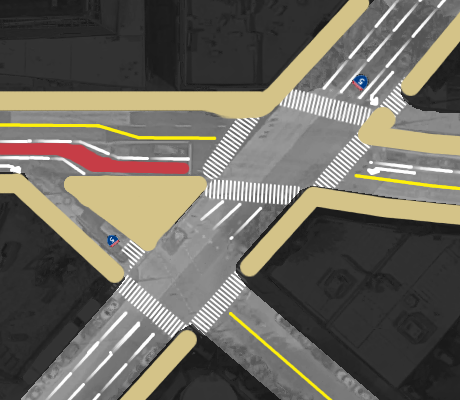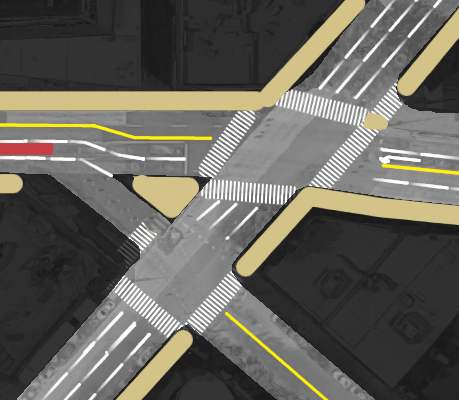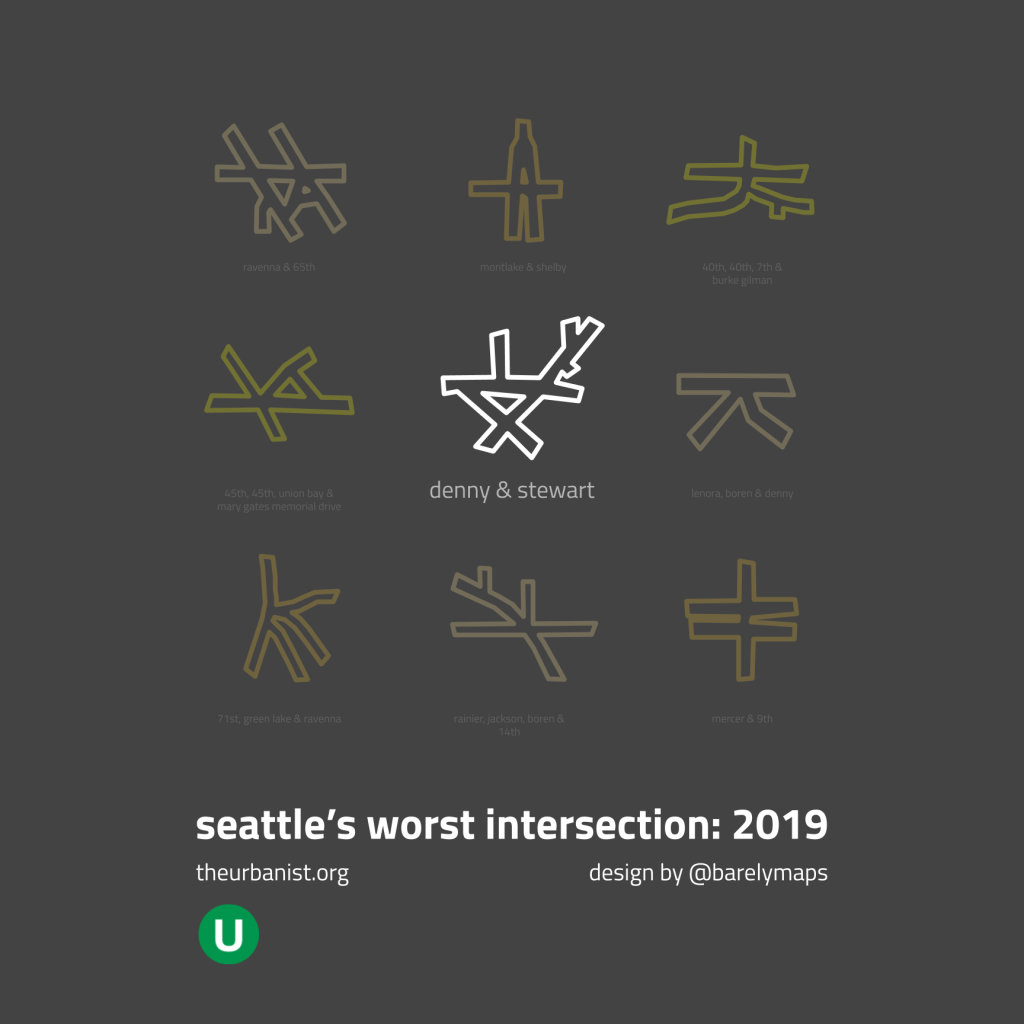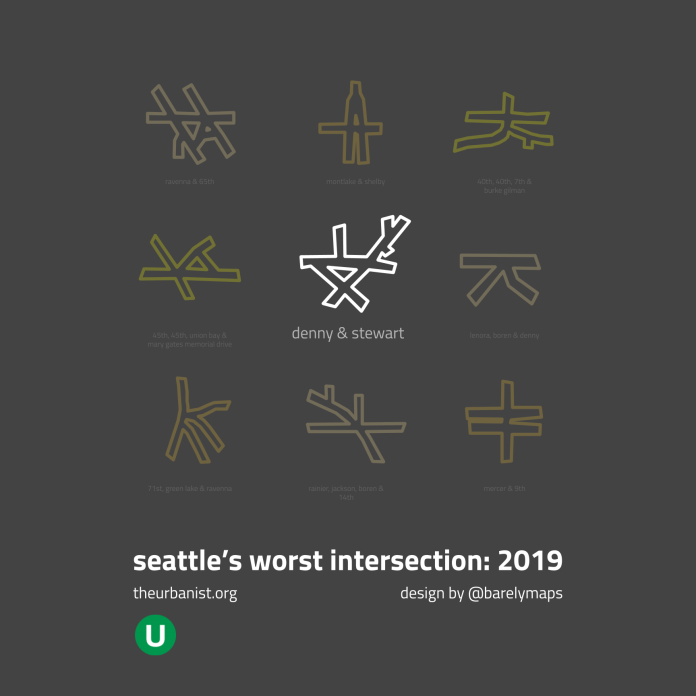We have a repeat winner of Seattle’s worst intersection, and it’s a doozy. Denny and Stewart beat out 18 other nominees this year to be voted as Seattle’s worst intersection by readers of The Urbanist.
The worst intersection in Seattle competition brings out the very best of the worst by inviting readers to nominate and vote for those crossroads that impede commutes and frustrate people on foot, riding bikes, or riding the bus.
This year’s competition had seven nominees from South Lake Union or Denny Triangle—so many that we added a runoff round this year to pare down the options.
Of the seven times that we’ve done this poll, an intersection with Denny Way has now won four times. Denny & Stewart was the worst intersection in Seattle just two years ago.
Why it’s the worst
Denny and Stewart may be the busiest Denny intersection, having to accommodate drivers getting off I-5 and going south on I-5, buses coming off the freeway to drop commuters downtown, and people walking along a busy route between Capitol Hill and South Lake Union.
The intersection fails everyone. Drivers can wait upwards of 30 minutes to pass through this intersection, and often block the crosswalk on the way through. People on foot (and sometimes other drivers) have to meander around those cars. And only the boldest cyclists pass through.
Riders waiting for Route 8 buses at the southwest corner of Denny and Stewart get a front-row seat to the madness, and all the exhaust.
People on foot should avoid the northeast corner of the intersection. You can’t get up to Capitol Hill from here anyway, since there’s no sidewalk on that side of the bridge, and there’s barely anywhere to stand.
Denny & Stewart beat out the other finalist, NE 40th St, NE 40th St, and 7th Ave NE, with 53% of the vote. The NE Seattle intersection may be the height of ridiculousness in Seattle transportation, but the dangerous Denny & Stewart is the height of negligence. While 40th, 40th, and 7th is confusing and chaotic, Denny and Stewart is downright dangerous. In fact, it was named the most dangerous intersection in Seattle, all the way back in 1971.
Denny and Stewart hasn’t changed much since then, much less since it was named Seattle’s worst intersection in 2017. However, other winners of the “worst intersection” competition have changed. The Seattle Department of Transportation (SDOT) just finished a redesign project at last year’s winner, Rainier & 23rd. Back in 2015, when the “worst intersection” was from a pedestrian perspective only, Denny and Terry won and since then had a pedestrian half-signal installed along with left-turn restrictions.
There have been minor changes at Denny & Stewart in recent years, including a restriction of Yale Ave to one-way and a new Route 8 bypass lane on Denny to speed up the chronically-late 8. And, SDOT claims collisions have been reduced since 2014. However, it’s still the worst intersection in Seattle.




Denny & Stewart. (Photos by author)
Recommendations
To solve this transportation cluster, we need the type of bold leadership that SDOT hasn’t had in the past and the prioritization of safe and healthy streets that the city does not seem to have in its current mayor. Here are some recommendations.
Striping and signage–low-hanging fruit
These are the kinds of simple changes that can be done for minimal cost and that SDOT should start on today:
- Outlaw right on red. Right turns on red should be banned in all downtown intersections, starting with traffic turning right onto Denny from Stewart. Drivers often encroach on the crosswalk, blocking pedestrians who are trying to cross Stewart.
- Add LPIs. SDOT recently announced a new policy to consider leading pedestrian intervals (LPIs) during signal maintenance. LPIs for people walking across Denny would be hugely beneficial so they can be seen by those same drivers trying to turn right onto Denny and so they can be seen by drivers turning left from Stewart to go up to Capitol Hill.
- Implement lane restrictions to reduce chaos. Drivers coming south on Stewart who are trying to turn left to Capitol Hill have to wait in line with traffic heading toward I-5. Making the left lane left-turn only, and restricting the second lane to just I-5 traffic would help to make the intersection more orderly by facilitating Capitol Hill traffic and identifying the correct lane for I-5-bound drivers.
Street construction
Bigger changes cost money but would transform the intersection and surrounding area from a pedestrian-hostile area to being somewhat pedestrian friendly.

Denny & Stewart with proposed changes 
Denny & Stewart today
- Reduce vehicle lanes from two to one lane uphill to Capitol Hill. With Denny’s eastbound right lane serving Route 8, there is only one general traffic lane going eastbound through the intersection. Re-striping the bridge to have only one lane going uphill and giving buses getting a queue jump will have minimal impact on traffic and make the next option possible.
- Add a sidewalk to the north side of Denny across I-5. For such a busy pedestrian route, it’s unacceptable that there only a sidewalk on one side. Currently, many people have to cross Denny twice in order to use the current sidewalk. And, if the bridge is re-striped to only have three traffic lanes, a new sidewalk would fit just fine and make it much easier for people on foot to get between South Lake Union and Capitol Hill.
- Increase size of pedestrian island on NE side of intersection. The current place for pedestrians to wait only has room for about three people. Adding a sidewalk on the north side of Denny would allow this to be expanded so that everyone who uses this busy route would have a place to stand.
- Increase size of bus stop triangle. Yale avenue was restricted to one lane in a recent project and the bus stop triangle where people wait for Route 8 was temporarily expanded. Now, however, building construction has routed I-5 bound traffic closer to the bus stop. The southeast-bound lane should be returned to its historical position and the bus stop should be expanded and redesigned with amenities to make the bus stop less exposed and more comfortable for the patient riders willing to wait for Route 8. Fortunately, changes to this area are already planned as part of the tower construction project across the street.
- Add a curb bulb on the northwest corner. Denny does not need to be this wide and a curb bulb would shorten the crossing distance, allowing people to walk across the intersection more quickly and visibly.
Enforcement
Law-breaking abounds in this chaotic intersection because at times it seems impossible to drive through without breaking the law. SPD should aggressively cite drivers for the following infractions:
- Stopping in the intersection, blocking other drivers or forcing people on foot to walk around their cars.
- Turning left onto Yale toward I-5 from the wrong lane.
- Running red lights.
SPD has done some enforcement at this intersection in the past but they should be out here every day until drivers learn better habits.
Reducing traffic
The problems with this intersection are so severe largely because the number of drivers trying to pass through is stressing the road network to capacity and exceeds the capacity of southbound I-5. While the suggestions above will help the intersection to be safer, they won’t fix its dysfunctional nature.
Fortunately, the mayoral administration is showing some boldness in studying one possible way to reduce traffic, which is congestion pricing. Implementing a fee to pass through the nearby I-5 onramp, along with the other downtown ramps, would reduce traffic, possibly to volumes that could let cars pass through efficiently without backing up and without blocking crosswalks. The money from congestion pricing could go toward some of the construction projects suggested above and toward better transit service.
Congestion pricing is complicated and raises valid equity concerns that should be considered, however it may be the only way to eliminate the gridlock that afflicts this intersection.
Another option: a roundabout
While we don’t see many roundabouts along Seattle arterials, the Washington State Department of Transportation is a fan of the proven benefits of roundabouts. It’s unclear whether a roundabout could handle this amount of traffic and reduce conflicts between people in cars and people on foot, but it may be worth a closer look.
Where do we go from here?
Denny and Stewart was voted as Seattle’s worst intersection from the perspective of people on foot, on bikes, and on buses. As we’ve seen with previous winners, it’s also one of the worst intersections for people in cars as well. Dysfunctional intersections like this don’t work well for any mode. When intersections are backed up, nobody can pass through efficiently, escalating driver aggression and increasing conflicts between people who are just trying to get where they’re going. Effective transportation planning is not a zero sum game. The suggestions above offer a way forward that make Denny and Stewart better for everyone.
The question is now, does the city have the leadership we need to work toward a healthy and effective transportation network? Maybe that’s too big of an ask, but can we at least fix this intersection?

Troy is a pedestrian advocate who serves on the board of Seattle Neighborhood Greenways. He loves cities and walking, hiking, and biking. He wrote a book to help others looking to find the right place for them, called Move to the Place of Your Dreams: A Relocation Handbook. By day, he is a professional consultant for a technology firm.


